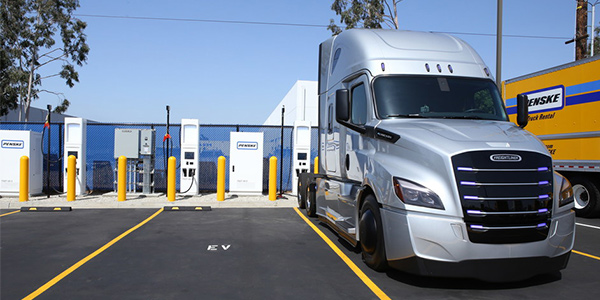The California Energy Commission earmarked up to $50 million in incentives for medium- and heavy-duty zero-emission vehicle (ZEV) charging and refueling infrastructure on Wednesday, adding to a large and growing pot of state funds for reducing greenhouse gas emissions in the transportation sector.
The incentives will be administered by CALSTART, a nonprofit group focused on clean transportation technologies. CALSTART Executive Vice President Bill Van Amburg said the $50 million block grant for commercial ZEV infrastructure can “set the state up for success and, by leadership example, the nation and the world as well.”
“We know from our work with industry and fleets, utilities and equipment providers, air districts [and] communities that streamlining the process and increasing the pace of deployment and scale and the penetration of zero-emission medium- and heavy-duty vehicles is critical for the state’s climate and air goals, and that it’s become really the long pole in the tent,” Van Amburg told the CEC. “The vehicles are becoming available, and now we need to really move the infrastructure.”
Transportation produces 41% of GHGs in California, with medium- and heavy-duty (MD/HD) vehicles spewing a disproportionate share, according to the CEC.
“Medium-duty and heavy-duty vehicles represent a small share of California registered vehicle stock, accounting for about 1 million out of 31 million vehicles, or 3%,” CEC staff wrote in a grant request. “However, this small number of vehicles is responsible for about 23% of on-road greenhouse gas emissions in the state because of comparatively low fuel efficiency and the high number of miles traveled per year.”
Large commercial vehicles account for 60% of nitrogen oxides (NOX) and 52% of particulate matter 2.5 micrometers (PM2.5) and smaller statewide, it said.
“For these reasons, MD/HD vehicles represent a significant opportunity to reduce GHG emissions and criteria emissions while focusing on a small number of vehicles,” the funding request said.
Since 2010, the state has invested $530 million in projects to increase the adoption of MD/HD ZEVs, with more than 9,000 vehicles already on the road. The high cost of infrastructure remains a barrier, requiring increased incentives, commission staff said.
The funding comes on top of massive infusions of state funds, primarily for passenger ZEVs.
In December, the CEC allocated $116 million for hydrogen fueling stations, and in August, the California Public Utilities Commission (CPUC) authorized $437 million to fund the installation of 38,000 charging ports for EVs through Southern California Edison’s Charge Ready program. (See CPUC OKs 1.2 GW of Storage by 2021, 38,000 EV Chargers.)
The grants are intended to help meet Gov. Gavin Newsom’s executive order, issued in September, requiring all new passenger cars and trucks sold in the state to be ZEVs by 2035 and all new MD/HD vehicles to be ZEVs by 2045. A 2018 executive order by Gov. Jerry Brown requires the state to have 5 million electric vehicles on the road by 2030. (See Calif. to Halt Gas-powered Auto Sales by 2035.)
California Air Resources Board regulations require an increasing number of trucks sold in California to be ZEVs starting in 2024 and for all trucks sold to be ZEVs by 2045.
The state needs to install hundreds of thousands of public charging spots and double its pace of EV sales to reach the passenger vehicle goals set by Brown and Newsom, researchers told the CEC last year. (See California Needs Huge Number of EV Chargers.)
For MD/HD trucks, preliminary estimates show the state may need to deploy at least 67,000 50-kW chargers and more than 10,500 350-kW chargers to serve future demand, they said.



